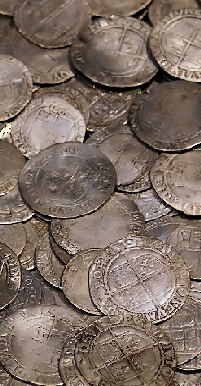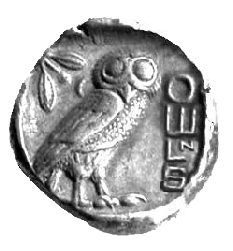
● Next Meeting Status:
Cancelled



● Host Society for the
BANS 2011 Congress
held in Southport


Truly Worthless, Or, The Nature Of Money
There is a general belief that coinage started somewhere in Asia Minor or the eastern
Mediterranean around 700BC, give or take fifty years, based on the fact that objects
which we recognise as coins apparently first appeared, near there, around then. As
coin collectors, it suits us to ignore the likelihood that other objects used as
money might have been around for a lot longer and, as we are coin collectors, we
can continue to ignore non-

We think that the first coins were lumps of a naturally occurring gold and silver alloy, which we call electrum, and which were stamped by the bureaucrats of Lydia, to guarantee their fineness, though who stamped the bureaucrats to guarantee their fineness remains an unanswered question. Gradually, as metallurgy improved, the metals became separated, and small lumps of gold, and larger lumps of silver, came into being, and went their own separate ways. The difficulty then, and ever since, was working out just how big a lump of silver was equal to a standard lump of gold, or vice versa. Two and a half thousand years have failed to produce a solution to that question.
Today, we can reveal the answer. It’s whatever you want it to be. And at the end
of the day, gold and silver are only worth what people are prepared to pay for them.
In a post-

However, for centuries past and only just now passing out of living memory, gold
and silver were regarded as the standards, the “A” Levels if you like, the store
of wealth. Great, if you are wealthy, but a trifle inconvenient for buying an egg
or a bowl of gruel. All this precious metal didn’t meet the demands of the day. What
was really needed was pocket money, the stuff we have today. But although the Romans,
and the Chinese, and to a degree the Greeks, eventually mastered the practice of
small change, it was a concept that only re-
In the end, more by default and exhaustion than anything else, it was generally agreed that this third tier of money would be provided by copper, and that it would be, well, more of a token or a promise of something, rather than a store of value. Not really money at all. But nonetheless we now had gold, silver, and copper. It was a monetary system which worked pretty well, until The Accountant came on the scene.

Accountants have this terrible view of the world: they need to justify everything. Why spend zillions on providing beautiful gold coinage, only to see it worn away and lost forever on the insides of trouser pockets, or purses? We can have neatly folding paper money, which won’t last as long, but will be a lot more practical. And cheaper. Why spend vast amounts on providing solid silver coins, when alloy or, even better, base coins will do just as well, and will be a lot more practical? And cheaper. And why spend that bit more on copper, when there are more durable, long lasting alternatives? Practical. And cheaper!
So now we have agreed, haven’t we, that coins don’t have to be gold, silver or copper any more? Good. If they aren’t themselves stores of value, it doesn’t actually really matter what they are made of, does it? The search was on for other materials.

Tin was an early substitute, probably because it looks a bit like silver and was
considered to be, at least, semi-
Nickel is another element that looks a bit like silver, is much more hard wearing,
keeps clean in use, so it should be ideal. The Canadians and South Africans thought
so, but then, they would. Between them they produce most of the world’s nickel. Unfortunately
it has two major disadvantages. Firstly, about 10% of the population is allergic
to nickel, and secondly, much more important, it is quite expensive. So nickel is
out. But hang on a mo. Suppose we mix it with something else, like copper? That reduces
allergic reactions and, guess what, it's cheaper. Fine, put cupro-

So now we have paper, cupro-
But hang on a mo. Victory’s round the corner, and we can spare a bit of our really
valuable metal, like chromium, nickel or copper, so why don’t we take a leaf out
of the tin can business, and start plating our coins? Nice one, Bruce. This gives
us an interesting range of alternatives. The Canadians liked the Chrome plated steel
look for their nickels, while in 1943 the Americans tried zinc plated steel for their
coppers. Possibly the nasty grey colour of the plated coins confused them, because
in 1944 all the surplus blanks were turned into 2 franc pieces, and sent to Belgium
as liberation money. After years of Nazis and zinc occupation money, no-

But just occasionally imagination and illogic wins. Faced with a wartime shortage
of nickel for their cupro-
Ah yes, the Euro. How political, how correct. The brass coinage isn’t actually brass
at all, of course. Oh dear me, no! It’s Nordic Gold. We would actually call it Aluminium
Bronze, but Nordic Gold sounds so much more valuable. It’s nickel-
So where do we stand now? I have to tell you that all around the world, the Accountants
have triumphed. Copper plated steel, brass plated steel, nickel plated steel are
the stuff of numismatic nightmares – just imagine a Petition Crown stuck in silver
plated steel or a Una and the Lion in Nordic Gold plated steel -

But in the ultimate analysis, it doesn’t really matter. We have achieved the goal – truly worthless money.
Chris Leather

Where to next?
